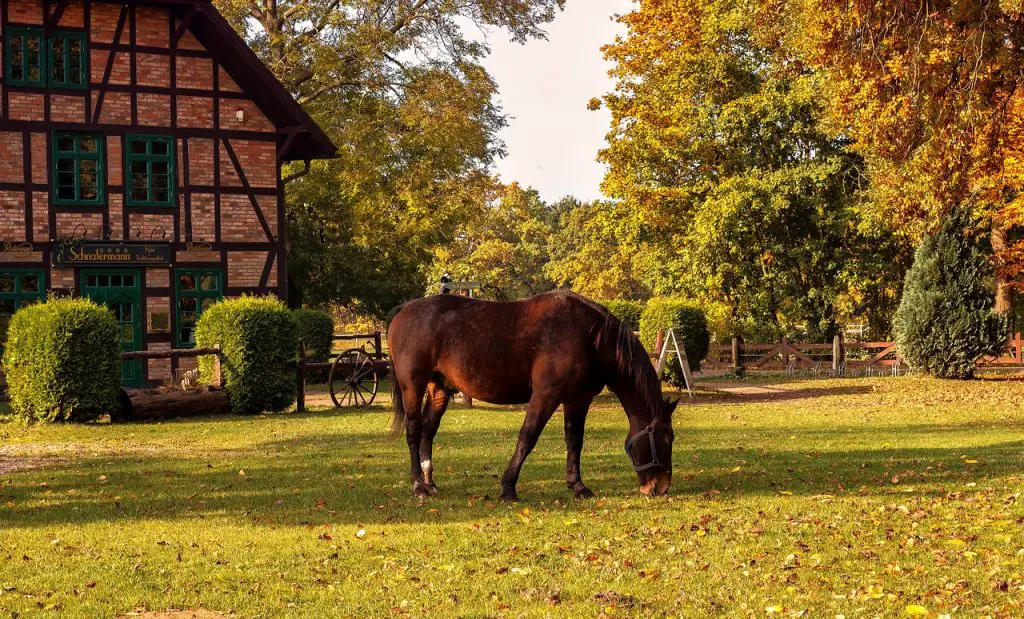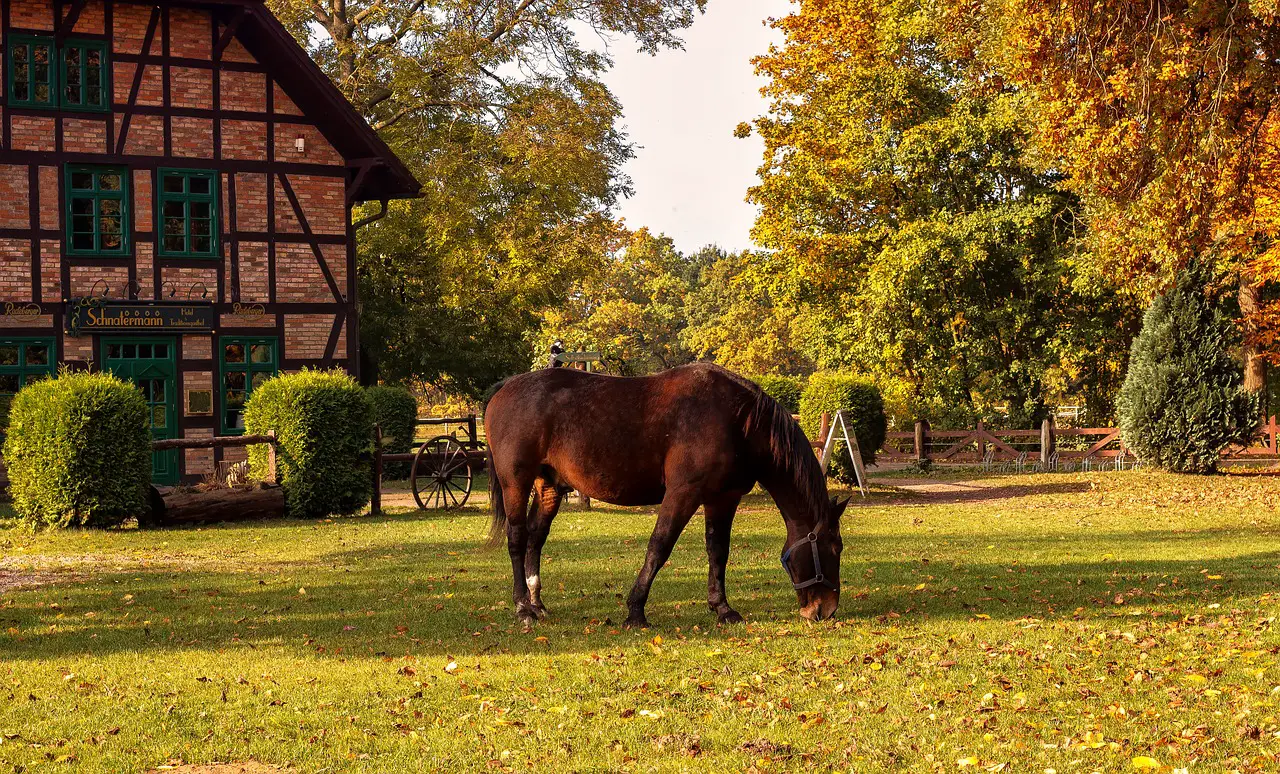Last Updated on February 28, 2022 by Allison Price
There are many manure management options available that can help you reduce the unsightly horse manure pile in your barnyard.
Manure is a natural part of owning a horse. An average Dobbin produces 40 pounds of horse manure each day. For a total per-month sum, multiply that number by 30 days. Multiply the by 12 month and you have more than 7 tonnes of waste each year. You can have double the amount of horses if you have more than one horse. Batman, holy humus! What are you going to do with all that stuff?
We asked the question online and other horse manure managers responded. We will share our solutions to minimize this organic byproduct of horse ownership. Read on, put down your pitchfork!

Solution #1 – Recycle it
What to do: Make a compost pile. A compost pile is a pile of organic material, in your case horse manure or bedding, that’s kept in a manner that encourages rapid decomposition and a decrease in bulk. You can add yard/garden clippings, as well as other garbage foodtuffs such as vegetable peelings to your compost pile.
How it Works: Composting organic matter creates heat, chemicals and beneficial bacteria which transforms it from rotten yuck to rich soil. In a matter of months, you can reduce the size of your pile by 50%. The end product can be used as topsoil for your garden, pastures, or lawns.
How To Do It: Here is a plan from our horse-manure managers.
- Make a composter. One horse’s waste can be accommodated in an 8-by-8 foot area, surrounded by three 5-foot walls. To accommodate horses, you can increase the area accordingly. Although you can make a compost pile from any ground, a cement pad makes it easier to use the tractor to manage the pile. You will learn more about this in a moment. You can build walls with concrete or cinder blocks, or 2-by-10s. If money and time are scarce (and they are often), Our manure managers tell us that you can start a compost heap on the ground and without any container walls. However, decomposition can be slowed. By allowing manure to pile high enough from one end to the other, it encourages rapid decomposition. To increase the heat of the sun, you can cover a compost pile with black plastic.
- Place your horse manure into the composter. Keep your compost pile as moist as possible to speed up decomposition. To regulate the moisture content of your compost pile, spray it occasionally with a hose and/or cover it with a plastic sheet to keep it dry from drying sun or excessive rains.
- It should be aired. You will need to “stir” the pile in order to achieve rapid and even decomposition. You need to stir the pile so that air and moist organic matter combine to accelerate the process of decay. Also, heat and bacteria will be spread throughout the pile to allow cooler areas to join in the fun. There are two methods to achieve aeration: passive and manual. You can manually stir your pile with a front-end loader or tractor. You can turn the pile more often to make it richer soil. You can also turn the pile using a shovel if you don’t own a tractor. However, it will take a lot more work.
Passive aeration requires no manual labor. Instead, place several 4- to 6-inch PVC pipe with holes (the ones used for septic systems), across the base of your pile before you start composting. You can also insert chimney-like pipes into the pile’s middle. You can increase the amount of aeration by using more pipes.
The upside: By converting your waste into useful, product-rich soil. It can be used on your own sandy soil or clay ground to make a fertile topsoil or sold to gardeners at a premium. In one Northwestern town, compost is available at the topsoil dealer for $8 per cyl. A properly functioning compost pile will also kill any parasites in its manure. You don’t have to worry about your fields being contaminated by equineworm larvae if you do use it. The heat also kills any weed seeds in hay or bedding and any undigested oats. This makes compost great for vegetable and flower gardens. Composting also reduces odors and flies.
Downside: Properly composting requires effort. You need to keep an eye on moisture levels and aerate the soil. Also, decomposition doesn’t happen overnight. The speed at which your compost “cooks”, depends on the weather and the waste content. Is the manure mixed with quickly decomposing bedding such as straw, fine shavings, sawdust, rice byproducts, and shredded computer paper? Or is it mixed with slower-to-break-down, dense wood shavings? A pile of 8-by-8-by-4-foot manure mixed with straw and fine shavings will take between 2 and 3 months to compost 50 percent.
Cost: Depending on the size of your retainer, your compost slab can cost anywhere from $500 to $1,000. Your cost will be minimal if you compost directly on the ground without walls. For pipe, passive aeration costs $25 to $25. For $10, you can buy a plastic tarp to protect your pile. Tip You can offset the cost of your compost pile by selling its byproduct.
Solution #2 – Spread It
What you do: A manure spreader is a large wagon that can be pulled behind a tractor or another vehicle. Spreaders use a belt mechanism that breaks down and scatters manure and bedding.
Why it Works: Instead of stockpiling horse manure you can shred it and immediately fertilize your pastures.
What to Do: Firstly, you need to buy a spreader. There are two options for mechanical power: ground-driven or PTO (power take-off). To run the shred-and spread machinery, PTO units need a tractor that has a PTO connection. They are more powerful and expensive than their ground-driven counterparts. Ground-driven units spread manure by using a beater driver that strikes the ground while the spreader rolls, and then throws it out. Spreaders like these do not require PTO and can be pulled by a truck, tractor or ATV.
The upside: There is no need to compost, so the manure pile will shrink every time you lift up the spreader. You can encourage waste to be broken down by spreading straw, manure, and shavings on pastures. This will also provide fertilization for no cost. You can also spread the composted soil from Solution 1 with your spreader.
The downside: You will need to find a neighbor who is willing to help you spread horse manure. You can spread the manure on your pastures but it will not kill equine parasites. You’ll probably be introducing parasites to your grazing areas. Keep your horses on a regular program of deworming. Tip Cattle-owning neighbors would appreciate your spreading efforts. Equine parasites aren’t an issue for cattle, so contamination shouldn’t be a problem.
You’ll also find that your stall waste has a high ratio of shavings to manure. This will result in a carbon-tonitrogen ratio which is too high for your soil. This means that your pasture will turn yellow. Mix shavings-rich refuse with a source of nitrogen such as bone meal, blood meal or straight nitrogen fertilizer before spreading it.
Price: Expect to spend $1,000 on a ground-driven manure spreader and $3,000 on a PTO unit. Towing costs (if you don’t own a truck or ATV), a basic 10-horsepower lawn mower will cost approximately $2,500. There are many tractors with PTO units. You can find used ones in good condition starting at $10,000.
Solution #3 – Use four-legged spreaders
What to Do: Use your horse, he’s a natural spreader of manure.
How it Works: Every time your horse is moved from a paddock to a stall, and onto fertiled areas, you have made a significant step towards lowering Mount Manure’s elevation. If your horse spends between 10 and 12 hours per day on pasture, it will have half the daily manure deposits in his paddock or stall. You’ll also have a happier horse!
How To Do It: Get him out!
The upside: You receive the same fertilizer for free as if you spread it manually, but without the high cost of equipment. One horse can produce approximately $150 worth fertilizer each year. Your horse also gets his daily exercise. Your shoveling and raking work will reduce your stress levels. You’ll also increase the durability of your stall bedding.
The downside: Parasites may be reintroduced to your pastures which could reinfect your horse. You may also need to periodically disperse piles if your horse poops in the same area.
Cost: Null if your horse uses all of the pasture as a toilet. Renting or buying a spring-tooth or divided-tooth harrow is a good option if your pasture is small or your horse poop in the same spot. This harrow does not require power to be attached to your vehicle. You can find used harrows at equipment auctions for as low as $100. We know of a vet that simply attaches an old chain link gate to her truck and drags it around to help break up manure piles in her pastures.
Solution #4 – Offer it up
What to do: Give it away or sell it.
How It Works: One man’s trash is another person’s treasure. You can either compost your manure, or pile it. This will give you a valuable commodity: fertilizer, soil, or both for gardens, lawns and pastures.
How To Do It: Place frequent ads in your local newspaper’s lawn-and garden section. Post flyers in nurseries and greenhouses. To find out if your fertilizer is available in their area, contact farmers and orchards. Don’t forget to put signs on your street.
The upside: You get your manure pile hauled away free. Some people, especially in the case with compost, will pay for it. Note To see the current rate for compost or manure in your area, check the lawn-and garden section of your newspaper.
The downside: Advertising is expensive and takes time. You will need to adjust your schedule to accommodate manure-seekers if the advertising is successful. You won’t be able to offer a free “we’ll load this for you” service to people who respond to your ad if you don’t own a tractor with a front-end loading machine. This means that you will have to either hope for (and deal) with) lots of people who want some manure or a few people who can haul large pieces from your pile.
Cost: You’ll spend a couple of dollars for a short “free horse manure” ad; pennies for home-computer-generated fliers; and a few more bucks for wooden signs out by your driveway.
Solution #5 – Bury It
What to Do: Use manure and shavings to fill a hole or ditch in your property, or to level low spots on it.
How It Works: It is the opposite of a heap! Consider buried manure your miniature biodegradable landfill.
How To Do It: Locate or create a place in your barnyard where manure can go to fill in and enhance soil areas. You don’t want to block natural drainage areas or create a ditch if you don’t have one.
Side: While you are disposing of manure, is being added to your land. It can be an easy and low-maintenance method to dispose of manure if you have a natural area to dig or a place to make one.
Downside Your fill material will eventually decompose, so you’ll need to periodically cover it with topsoil. This will level it and stabilize it. This is particularly important if you have horses or people who will be walking through the area.
Cost: Null if your topography is natural. It will cost you more if you need to hire a bulldozer or backhoe service to create one. Depending on the rock content in your soil, a bulldozer can dig a fill hole up to 4 feet deep and 50 feet wide in under a day. Although prices for bulldozer and backhoe services can vary from one area to another, they generally cost $65 an hour. Caution: Make sure that any ditch or hole you dig is not accessible to horses and people. It would be a terrible thing for anyone to fall in and get hurt!
Solution #6 – Reduce It
What to Do: Reduce the amount of bedding that you use.
How It Works: The more manure you use, the simpler it is to clean up and the smaller the waste pile.
How it works: You can reduce the amount you use by using stallmats. After the mats have been installed, you should only cover the areas where your horse urinates. You can further manage your manure mountains by choosing bedding materials that quickly break down such as rice hulls, straw, computer paper, or shredded computer paper. These materials biodegrade 10x faster than shavings. One manure manager told us that the local landscaping supply company stores wheat residue from the production of garden fabric. It is claimed to be a better bedding material than wood shavings because it is more absorbent and biodegradable. It’s also free to haul!
The upside: You will save money on bedding as you use less. It will also help you save time and effort on stall-cleaning chores. Alternative beddings can be cheaper than wood shavings and are more absorbent. They may also be more absorbent than shavings.
Downside – Stall Mats can be expensive additions to your barn. However, they will eventually net you savings on bedding costs. The country you live in will determine the quality and quantity of your alternative bedding. You won’t find a stall with deep bedding.
Price: A 4-by-6-foot stall mat costs approximately $50. Rubber conveyor belting can work just as well, and is much more affordable if purchased from your local concrete-making company. For maximum ground coverage, choose belting at least 36 inches wide. For hauling, alternative bedding is often available at no cost.
Solution #7 – Get Rid of It
What to Do: Locate a waste-removal company.
How It Works: You place your manure into a container, such as a dumpster. It is regularly taken off by the service.
How to Do it: If your horses are small, you might find that you can reduce the bedding and practice other alternatives. You can then put your manure in garbage cans and have it picked up by your regular garbage service. Check with your service first to make sure they allow such waste. Renting a dumpster is an option if you have additional horses.
The upside: There’s no need. There is no fuss. Regular hauling of manure from your facility prevents reinfestation with parasites and reduces fly problems.
The downside: Your trash service might not be able to haul manure. The cost of renting a dumpster can vary depending on where you live. You will also need to manage the logistics of loading your manure in the dumpster.
Price: According the people we spoke to, dumpster services ranged between $40 every 3 Months in Nevada (a bargain!). South Carolina: $68 per month. Tip You can share the dumpster costs with your fellow boarders if you board horses. F
The editors would like to thank Alayne Blickle (program director for Horses for Clean Water), a Washington state-funded program.


